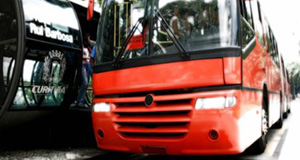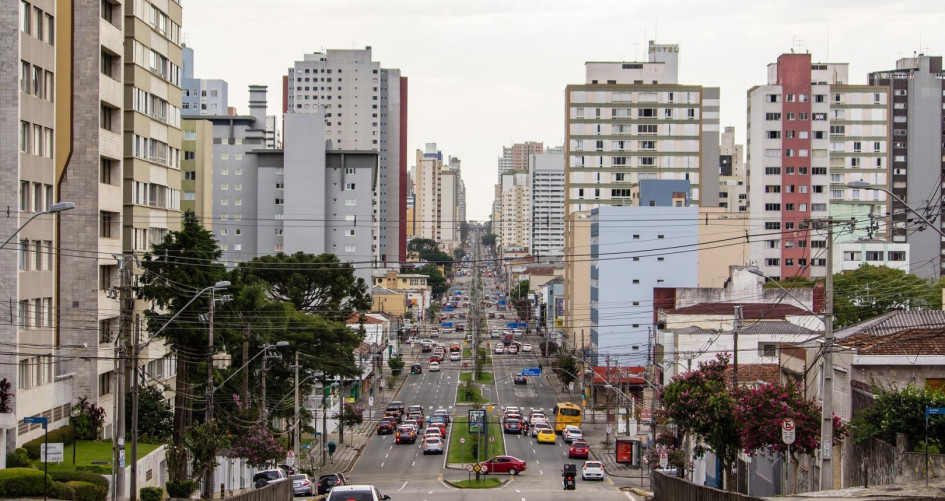Project update, December 2012
- For Curitiba, the BRT system has been a great success. The results have been an improved quality of life in the city, as well as significant environmental progress. One of the success factors for Curitiba's BRT system has been connecting public buses to a 3G mobile-broadband network. This has helped to improve real-time planning and make bus operations more efficient and effective, contributing directly to CO2 emission reductions.
- As part of studies that explore ICT solutions and their potential CO2 emissions reductions, Ericsson has conducted a life-cycle-based analysis of CO2 emissions related to the BRT system in Curitiba, confirming that the integrated 3G mobile-broadband network has helped to reduce the carbon footprint of the transport system. The report is available here.
Project Background
For more information
Location: South America, Brazil, Paraná / Curitiba
Date project established: June 2010
Curitiba, Brazil’s seventh-largest city with a metro area population approaching 3.5 million, has long been a leader in sustainable development and quality of life. Forbes magazine, citing reports calling Curitiba one of the world’s “greenest” cities, says it is famous for its rapid bus-based public transport – used by 70 percent of the population – and its advanced economic development.
Ericsson has deployed an innovative transport solution based on 3G/WCDMA mobile broadband for URBS who is responsible for the operation and supervision of Curitiba’s transportation and transit systems. The system uses Ericsson’s F3607GW module, a fast mobile broadband module with reduced power consumption and high-performance GPS. Ericsson mobile broadband modules unleash the true potential of advanced HSPA mobile broadband technology. Vivo, the leading mobile operator in Brazil, and Dataprom, an innovative Brazilian supplier of solutions for public transport, chose Ericsson as a partner thanks to its track record for customer support and quick service, as well as its mobile broadband modules.
The new solutions, through electronic ticketing, opens up possibilities for new traveler services that can help people plan their route and enable them to purchase tickets wherever and whenever it is most convenient increasing customer satisfaction and security for staff and passengers.
A machine-to-machine communication solution developed by local partner Dataprom gives the Curitiba public transport authority URBS a wide range of information about its fleet. URBS can now monitor bus routes, time spent at bus stops, speed, distance traveled, and times for arrival and departure. Fleet management systems, controllers can access information about and monitor their fleet.
More efficient public transport, reduced emissions and energy use, and a modern mobile broadband network for bus passengers: mobile broadband modules from Ericsson are making life better for people in the Brazilian city of Curitiba.
The solution has already been rolled out to 2,500 buses, and soon to reach 3,000, the system will get additional functions such as user information panels, wireless network access for passengers and CCTV for security.
Mitigation and/or Adaptation
Smarter public transport is an increasingly popular way for cities to minimize their carbon footprint. Using mobile broadband, cities and regions can both improve the efficiency of their own bus, train and tram services and attract more people to switch from private vehicles to public transport, reducing traffic congestion, fuel consumption and carbon emissions.
Mobile broadband connections allow information to be sent both to and from the vehicles, improving fleet management, network planning, customer satisfaction and security for staff and passengers.
More efficient public transport, mitigates emissions and energy use, and a modern mobile broadband network for bus passengers: mobile broadband modules from Ericsson improves the public transport experience and so promotes more usage of the system compared with private transport e.g. cars.
The system monitors passengers in and out the bus and when the bus is full it sends a new bus to the same route. This practice helps to reduce the fuel consumption, due to reduced bus stops, while building a faster public transport to the passengers.
Ericsson uses a life cycle assessment (LCA) approach when quantifying our carbon footprint and has now broadened this approach to also estimate the enabling effect of ICT to mitigate the carbon footprint of other sectors. Although we have not measured the savings for this particular case we are increasingly calculating it for other cases around the world e.g. health care, field force management, mobile money, collaborative work etc.
The general approach Ericsson uses is detailed in the white paper “Measuring Emissions Right”.
Social Benefits
Ericsson has established a Networked Society City Index in a joint study conducted by Ericsson and management consultancy Arthur D. Little. The index demonstrates that cities with a high level of ICT maturity are better able to manage issues such as environmental management, infrastructure, public security, health-care quality and education i.e. provide triple-bottom-line benefits derived from ICT maturity.
With regard to the Curitiba case citizens can enjoy improved public transport services based on high-bandwidth connectivity. The system provides substantial improvements compared with a previous 2G mobile communication setup, with more reliable connections and wider coverage. The number of customer complaints about the network has fallen from around 100 a month before launch to close to zero.
Potential for Scaling-up of project
It is foreseen that 70 percent of the world’s population will live in cities by the year 2050, therefore public transport will play a key role in sustainable cities.
Mobile broadband solutions like these play a key role in Ericsson’s vision of connecting more than 50 billion devices by 2020, and of a Networked Society.
This solution can be easily scaled up for other transport systems globally as the technology is well established and Ericsson provides services such as network roll-out and system integration which are key in implementing a successful project.
Potential for Scaling-up and replication of project
It is foreseen that 70 percent of the world’s population will live in cities by the year 2050, therefore public transport will play a key role in sustainable cities.
Mobile broadband solutions like these play a key role in Ericsson’s vision of connecting more than 50 billion devices by 2020, and of a Networked Society.
This solution can be easily scaled up for other transport systems globally as the technology is well established and Ericsson provides services such as network roll-out and system integration which are key in implementing a successful project.
Most of Brazilian State capitals are moving towards this type of solutions. These key cities are contacting Ericsson to with the intention of fully or partially replicating this project.
A similar approach has been taken in the city of Pančevo (Serbia), where Telekom Srbija and Ericsson signed a protocol on cooperation that allow the citizens of Pančevo to use the “smart services” – Eco Bus and Bus Tracker. These services make it possible for the citizens to check the quality of the air in the city and the position of the bus in public transport at anytime or anywhere.
This project also contains elements of adaptation related to awareness in an attempt to change the citizens’ attitude towards the environment and also improve the quality of their everyday life.




Images owned by the activity partners, all rights reserved.

